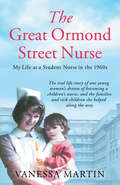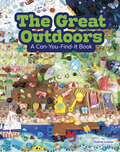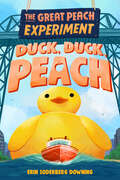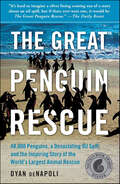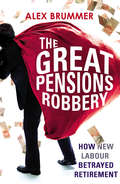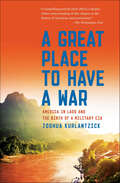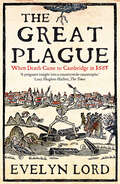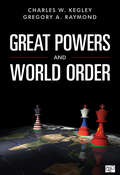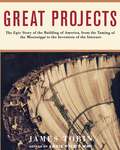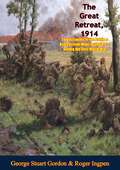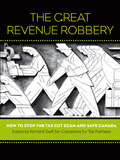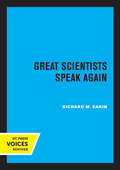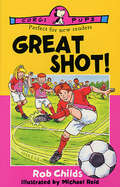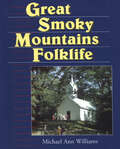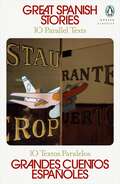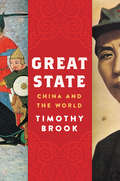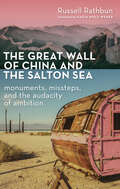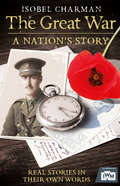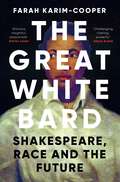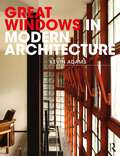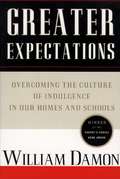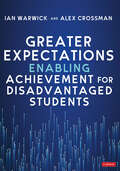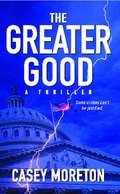- Table View
- List View
Great Ormond Street Hospital Nurse: The life of a trainee nurse at GOSH in the 1960s
by Vanessa Martin"You must learn to hold in your feelings," Matron said, firmly but not unkindly. "One day it will be your duty to support the family and other staff through this tragedy. You need to be strong." From the first time Vanessa Martin sets foot inside the world's most renowned children's hospital, she knows that she will never have another dull moment. From her first confrontation with the legendary matron, to consoling hordes of worried parents and caring for the wonderful bundles of joy themselves, Vanessa enters a world full of laughter, heartache and, most importantly, hard work.In this heartwarming memoir of a passionate, determined young woman trying to help as many children as she can, Vanessa pulls back the curtain on the bustling world of 60s London, and tells the remarkable story of finding her place within it.Nostalgic, charming and full of heart, The Great Ormond Street Nurse is the heroic tale of a woman who has dedicated over 40 years to the NHS.
The Great Outdoors: A Can-you-find-it Book (Can You Find It? Ser.)
by Chelsey LuciowAn elephant hides on the beach. A strawberry hides at a campsite. A ghost hides in the snow. Do you see the giraffe on the mountain? Can you find them in this fun book of photo puzzles?
The Great Peach Experiment 4: Duck, Duck, Peach (The Great Peach Experiment #4)
by Erin Soderberg DowningThe fourth Great Peach book finds the family back in Duluth, Minnesota for a summer filled with mystery, competition, pie, and . . . the World&’s Largest Rubber Duck.School&’s out soon, and the Peaches are looking forward to some quiet, especially now that the family&’s B&B (aka the "Peach Pit") is finally running smoothly. But quiet and normal aren&’t really the Peach way. When a massive Festival of Ships sails into their town, of course the Peaches have to dive in head-first. Ships of all kinds start rolling in: pirate ships, tall sailboats, tug boats, snazzy speed boats. And the highlight of the whole show: The WORLD&’S LARGEST RUBBER DUCK. Suddenly the Peachtree B&B is sold out, and the Peaches are cooking up other tasty solutions. But then the World&’s Largest Rubber Duck goes missing! Stolen? Sunk? Airlifted by aliens? The hunt is on for the famous icon, and the Peaches are leading the search. Using all their skills—on land and water—they are determined to find the missing duck and bring it back to its home in the harbor.The fourth book in the Great Peach Experiment series, Duck, Duck, Peach serves up a major mystery along with more challenges, humor, and family mis-adventures.A Junior Library Guild Gold Standard Selection
The Great Penguin Rescue: 40,000 Penguins, a Devastating Oil Spill, and the Inspiring Story of the World's Largest Animal Rescue
by Dyan deNapoliON JUNE 23, 2000, the iron-ore carrier MV Treasure, en route from Brazil to China, foundered off the coast of Cape Town, South Africa, spilling 1,300 tons of oil into the ocean and contaminating the habitat of 75,000 penguins. Realizing thJuneat 41 percent of the world’s population of African penguins could perish, local conservation officials immediately launched a massive rescue operation, and 12,500 volunteers from around the globe rushed to South Africa in hopes of saving the imperiled birds.Serving as a rehabilitation manager during the initial phase of the three-month rescue effort, Dyan deNapoli—better known as "the Penguin Lady" for her extensive work with penguins—and fellow volunteers de-oiled, nursed back to health, and released into the wild nearly all of the affected birds. Now, at the tenth anniversary of the disaster, deNapoli recounts this extraordinary true story of the world’s largest and most successful wildlife rescue. When she first entered the enormous warehouse housing most of the 19,000 oiled penguins, the birds’ total silence told deNapoli all she needed to know about the extent of their trauma. African penguins are very vocal by nature, prone to extended fits of raucous, competitive braying during territorial displays and pair-bonding rituals, but these poor creatures now stood silently, shoulder to shoulder, in a state of shock. DeNapoli vividly details the harrowing rescue process and the heartbreaking scenarios she came up against alongside thousands of volunteers: unforgettable images of them laboriously scrubbing the oil from every penguin feather and force-feeding each individually; the excruciatingly painful penguin bites every volunteer received; and the wrenching decisions about birds too ill to survive. She draws readers headfirst into the exhausting physical and emotional experience and brings to life the cast of remarkable characters—from Big Mike, a compassionate Jiu-Jitsu champion with a booming voice, who worked every day of the rescue effort; to a man named Welcome, aka "the Penguin Whisperer," who had the amazing ability to calm any penguin he held in his arms; to Louis, a seventeen-year-old medical student who created a new formula for the highly effective degreaser used by the rescue mission—whose historic and heroic efforts saved the birds from near extinction. The extraordinary international collaboration of scientists, zookeepers, animal rescue groups, and thousands of concerned individuals helped save the African penguins—recently declared an endangered species—from an all-too-common man-made disaster.DeNapoli’s heartwarming and riveting story is not just a portrait of these captivating birds, nor is it merely a cautionary tale about the environment. It is also an inspirational chronicle of how following one’s passion can lead to unexpected, rewarding adventures—and illustrates not only how people from around the world can unite for a greater purpose, but how they can be extraordinarily successful when doing so. The Great Penguin Rescue will inspire readers to believe they can make a difference
The Great Pensions Robbery: How New Labour Betrayed Retirement
by Alex BrummerOnce upon a time Britain's pension system was admired around the world. Now, it's in tatters and vast numbers of people face the grim choice of enduring a poverty-stricken future or working until they drop. What on earth went wrong?In The Great Pensions Robbery award-winning journalist Alex Brummer ventures into the corridors of power to find out how politicians bent on penny-pinching, a civil service cowed into submission and individuals more interested in their careers than public service have all taken a part in fatally undermining a 100-year-old system. It's also a story of breathtaking hypocrisy, where those in charge have feather-bedded their own pensions while destroying those of ordinary people. And, as Brummer convincingly argues, we're only just starting to live with the appalling consequences.
A Great Place to Have a War: America in Laos and the Birth of a Military CIA
by Joshua KurlantzickThe untold story of how America&’s secret war in Laos in the 1960s transformed the CIA from a loose collection of spies into a military operation and a key player in American foreign policy.January, 1961: Laos, a tiny nation few Americans have heard of, is at risk of falling to communism and triggering a domino effect throughout Southeast Asia. This is what President Eisenhower believed when he approved the CIA&’s Operation Momentum, creating an army of ethnic Hmong to fight communist forces there. Largely hidden from the American public—and most of Congress—Momentum became the largest CIA paramilitary operation in the history of the United States. The brutal war lasted more than a decade, left the ground littered with thousands of unexploded bombs, and changed the nature of the CIA forever.With &“revelatory reporting&” and &“lucid prose&” (The Economist), Kurlantzick provides the definitive account of the Laos war, focusing on the four key people who led the operation: the CIA operative whose idea it was, the Hmong general who led the proxy army in the field, the paramilitary specialist who trained the Hmong forces, and the State Department careerist who took control over the war as it grew.Using recently declassified records and extensive interviews, Kurlantzick shows for the first time how the CIA&’s clandestine adventures in one small, Southeast Asian country became the template for how the United States has conducted war ever since—all the way to today&’s war on terrorism.
The Great Plague: A People's History
by Evelyn LordIn this intimate history of the extraordinary Black Plague pandemic that swept through the British Isles in 1665, Evelyn Lord focuses on the plague’s effects on smaller towns, where every death was a singular blow affecting the entire community. Lord’s fascinating reconstruction of life during plague times presents the personal experiences of a wide range of individuals, from historical notables Samuel Pepys and Isaac Newton to common folk who tilled the land and ran the shops. She brings this dark era to vivid life through stories of loss and survival from those who grieved, those who fled, and those who hid to await their fate.
Great Powers and World Order: Patterns and Prospects
by Charles W. Kegley Gregory A. RaymondGreat Powers and World Order encourages critical thinking about the nature of world order by presenting the historical information and theoretical concepts needed to make projections about the global future. Charles W. Kegley and Gregory Raymond ask students to compare retrospective cases and formulate their own hypotheses about not only the causes of war, but also the consequences of peace settlements. Historical case studies open a window to see what strategies for constructing world order were tried before, why one course of action was chosen over another, and how things turned out. By moving back and forth in each case study between history and theory, rather than treating them as separate topics, the authors hope to situate the assumptions, causal claims, and policy prescriptions of different schools of thought within the temporal domains in which they took root, giving the reader a better sense of why policy makers embraced a particular view of world order instead of an alternative vision.
Great Powers and World Order: Patterns and Prospects
by Charles W. Kegley Gregory A. RaymondGreat Powers and World Order encourages critical thinking about the nature of world order by presenting the historical information and theoretical concepts needed to make projections about the global future. Charles W. Kegley and Gregory Raymond ask students to compare retrospective cases and formulate their own hypotheses about not only the causes of war, but also the consequences of peace settlements. Historical case studies open a window to see what strategies for constructing world order were tried before, why one course of action was chosen over another, and how things turned out. By moving back and forth in each case study between history and theory, rather than treating them as separate topics, the authors hope to situate the assumptions, causal claims, and policy prescriptions of different schools of thought within the temporal domains in which they took root, giving the reader a better sense of why policy makers embraced a particular view of world order instead of an alternative vision.
Great Projects: The Epic Story of the Building of America, from the Taming of the Mississippi to the Invention of the Internet
by James TobinSince the earliest days of the republic, great engineering projects have shaped American landscapes and expressed American dreams. The ambition to build lies as close to the nation's heart as the belief in liberty. We live in a built civilization, connected one to another in an enormous web of technology. Yet we have all too often overlooked the role of engineers and builders in American history. With glorious photographs and epic narrative sweep, Great Projects at last gives their story the prominence it deserves.Each of the eight projects featured in this masterful narrative was a milestone in its own right: the flood-control works of the lower Mississippi, Hoover Dam, Edison's lighting system, the spread of electricity across the nation, the great Croton Aqueduct, the bridges of New York City, Boston's revamped street system, known as the Big Dig, and the ever-evolving communica- tions network called the Internet. Each project arose from a heroic vision. Each encountered obstacles. Each reveals a tale of genius and perseverance.James Tobin, winner of a National Book Critics Circle Award, explains the four essential tasks of the engineer: to protect people from the destructive force of water while harnessing it for the enormous good it can do; to provide people with electricity, the motive force of modern life; to make great cities habitable and vital; and to create the pathways that connect place to place and person to person. Tobin focuses on the indi- viduals behind our greatest structures of earth and concrete and steel: James Buchanan Eads, who walked on the floor of the Mississippi to learn the river's secrets; Arthur Powell Davis and Frank Crowe, who imagined a dam that could transform the West; Thomas Edison, who envisioned a new way to light the world; Samuel Insull, the organizational mastermind of the electrical revolution; the long-forgotten John Bloomfield Jervis, who assured New York's future with the gift of clean water; Othmar Ammann, the modest Swiss-American who fought his mentor to become the first engineer to bridge the lower Hudson River; Fred Salvucci, the antihighway rebel who transformed the face of Boston; and J.C.R. Licklider, the obscure scientist who first imagined the Internet. Here, too, are the workers who scorned hardship to turn the engineers' dreams into reality, deep underground and high in the sky, through cold and heat and danger. In Great Projects -- soon to be a major PBS television series by the Emmy Award-winning Great Projects Film Company -- we share their dreams and witness their struggles; we watch them create the modern world we walk through each day -- the "city upon a hill" that became our America.
The Great Retreat, 1914: During the First World War [Illustrated Edition]
by George Stuart Gordon Roger IngpenIncludes The First World War On The Western Front 1914-1915 Illustrations Pack with 101 maps, plans, and photos.“Two views of the Great RetreatImperial Germany had long planned the conflict that was to become the First World War, but when the onslaught came there was little sign that the nations which would be embroiled were prepared for the storm. Germany advanced in the east and west where French and Belgian armies were forced to retire by overwhelming odds. The small British Army, the 'B. E. F', was rushed to the continent with most of its troops having less than a week between garrison life and the firing line. Under Sir John French, it was allocated the western end of the line, and at Mons it inflicted far more causalities on the enemy than its numbers would suggest. No army of its size, however, could stand against the German superiority in men (at least five to one) or artillery and machine guns. An envelopment was inevitable and so a stubbornly fought retreat was ordered. Near Le Cateau, the British turned at bay and Smith-Dorrien's determination to stand and fight undoubtedly saved the British Army from annihilation. Many people imagine the First World War as a stalemate of mud, wire and trenches, but in the first six months it was a great European war fought in much the same way that Napoleon, Wellington and Blucher had fought a century before.”-Print ed.
The Great Revenue Robbery: How to Stop the Tax Cut Scam and Save Canada
by Canadians for Tax FairnessAny attempt to restore responsible environmental policies, revive and expand our social programs, rebuild our crumbling infrastructure, and boost our flagging economy will be inadequate unless we also address the need to increase governments’ fiscal capacity. The tax system can also play a key role in closing the gap between rich and poor––a gap that is undermining the health of our economy and threatening damage to our democracy. Until recently, many progressive groups, including progressive political parties, have shied away from advocating for tax fairness and tax reform, fearing that the issue is political dynamite. Right wingers have encountered little opposition to their calls for deep tax cuts, especially for the rich and for corporations. But the tide is turning. Public opinion polls tell us that faced with growing inequality and cutbacks to government programs, Canadians now strongly support tax fairness, including higher taxes on the rich and on corporations. The Great Revenue Robbery is a collective effort to stimulate much-needed discussion about how tax policy can help rebuild our social programs, reduce the gap between rich and poor, restore environmental responsibility, and revitalize our country’s democracy.
Great Scientists Speak Again
by Richard M. EakinThe author writes of this book: "'What lead you to impersonate great biologists?' is a question often asked of me. My answer varies depending upon the interviewer. Sometimes I cite my interest in biographies of distinguished scientists initiated by a reading of Vallery-Radot's The Life of Pasteur as a teenage and furthered by a superb college course on the history of biology. Another answer: my love of the theater, more from the balcony than on the stage as a ham actor. My most frequent reply, however, credits this instructional innovation to the students in my Berkeley course in general biology (Zoology 10), who began to show, in the late sixties, their dissatisfaction with the lecture system. "I gave serious thought to the problem of communicating biological information with greater impact. One morning in the shower I was stuck not only by the spray but also by an idea: dress up and make up as some of the great biologists and present their discoveries and thoughts in their own words. In addition to expounding their scientific work, portray them as persons with hopes and ambitions, frustration over failure, and joy from success. I chose Darwin, Mendel, Harvey, and Pasteur, who would probably be on the most lists of great biologists, and two lesser-known scientists: William Beaumont, pre-Civil War Army surgeon who studied gastic digestion in the stomach of a fur-trapper, Alexis St. Martin; and Hans Spemann, 1935 Nobel Laureate in Physiology and Medicine, who discovered the organizer principle in embryonic development. The results of the innovation, which I call guest lecturers, were gratifying. "Late five of the lectures, in abbreviated form, were recorded on motion picture film (available through the Media Center of the University of California, Berkeley). Then it was suggested that a much wider audience should be reached through publication of the lectures in book form, illustrated with photographs of the 'guest lecturers' in action and with drawings, charts, maps, and reproductions of lantern slides." This title is part of UC Press's Voices Revived program, which commemorates University of California Press's mission to seek out and cultivate the brightest minds and give them voice, reach, and impact. Drawing on a backlist dating to 1893, Voices Revived makes high-quality, peer-reviewed scholarship accessible once again using print-on-demand technology. This title was originally published in 1975.
Great Shot!
by Rob ChildsHave a go! Shoot!"Tom, captain of the school football team, can't believe what is happening. Everyone in the team is scoring goals - except him. He even misses a penalty! But when his teammate Jonty is suddenly in danger, Tom needs to find his shooting boots again - and quickly!
Great Smoky Mountains Folklife
by Michael Ann WilliamsThe Great Smoky Mountains, at the border of eastern Tennessee and western North Carolina, are among the highest peaks of the southern Appalachian chain. Although this area shares much with the cultural traditions of all southern Appalachia, the folklife here has been uniquely shaped by historical events, including the Cherokee Removal of the 1830s and the creation of the Great Smoky Mountain National Park a century later. This book surveying the rich folklife of this special place in the American South offers a view of the culture as it has been defined and changed by scholars, missionaries, the federal government, tourists, and people of the region themselves. Here is an overview of the history of a beautiful landscape, one that examines the character typified by its early settlers, by the displacement of the people, and by the manner in which the folklife was discovered and defined during the nineteenth and twentieth centuries. Here also is an examination of various folk traditions and a study of how they have changed and evolved.
Great Spanish Stories: 10 Parallel Texts (Parallel Texts)
by VariousA riveting selection of short stories in Spanish alongside their English translations This new dual-language edition of ten stories selected from The Penguin Book of Spanish Short Stories celebrates some of the very best twentieth-century literature from Spain. Each story appears in Spanish alongside an expert English translation, providing unique cultural insight and literary inspiration for language learners. Ranging from a poignant tale of betrayal to a darkly humorous exchange between wedding guests, this captivating collection includes works from authors such as Leopoldo Alas (Clarín), Cristina Fernández Cubas, Medardo Fraile, Carmen Martín Gaite, Karmele Jaio, Carmen Laforet, Javier Marías, Carme Riera, Manuel Rivas, and Esther Tusquets.
Great State: China and the World
by Timothy BrookThe world-renowned scholar and author of Vermeer’s Hat does for China what Mary Beard did for Rome in SPQR: Timothy Brook analyzes the last eight centuries of China’s relationship with the world in this magnificent history that brings together accounts from civil servants, horse traders, spiritual leaders, explorers, pirates, emperors, migrant workers, invaders, visionaries, and traitors—creating a multifaceted portrait of this highly misunderstood nation.China is one of the oldest states in the world. It achieved its approximate current borders with the Ascendancy of the Yuan dynasty in the thirteenth century, and despite the passing of one Imperial dynasty to the next, has maintained them for the eight centuries since. China remained China through the Ming, the Qing, the Republic, the Occupation, and Communism. But despite the desires of some of the most powerful people in the Great State through the ages, China has never been alone in the world. It has had to contend with invaders as well as foreign traders and imperialists. Its rulers for the majority of the last eight centuries have not been Chinese.China became a mega-state not by conquering others, Timothy Brook contends, but rather by being conquered by others and then claiming right of succession to the empires of those Great States. What the Mongols and Manchu ruling families wrought, the Chinese ruling families of the Ming, the Republic, and the People’s Republic, have perpetuated. Yet a contemporary Chinese idea of a ‘fatherland’ that is, and always has been, completely and naturally Chinese persists. Brook argues that China, like everywhere, is the outcome of history, and like every state, rests on its capacities to conquer and suppress.In The Great State, Brook examines China’s relationship with the world at large for the first time, from the Yuan through to the present, by following the stories of ordinary and extraordinary people navigating the spaces where China met, and continues to meet, the world. The Great State includes black-and-white photos throughout.
The Great Wall of China and the Salton Sea: Monuments, Missteps, and the Audacity of Ambition
by Russell RathbunWe've been building and making things ever since we stumbled out of Paradise. Some of those things are incredible continuations of God's creation, while others are nothing but ambitious catastrophes. We continue making, says Russell Rathbun, but we've lost ourselves in the process. So how do we find ourselves again—rebuild our connections to each other, the earth, maybe even God? In search of an answer, Rathbun drives cross-country to the Salton Sea and takes a trip to China's Great Wall, interspersing his traveling revelations with engaging musings on Madame Mao's Gang of Four, Grandpa Webb's family secret, the Great Flood and the Tower of Babel, and a host of other subjects that grab his attention. With cheeky wit and sharp insight, Rathbun uncovers a way of finding ourselves and the deep connections we long for in an increasingly complex world.
The Great War: The People's Story (Official TV Tie-In)
by Isobel CharmanDuring the First World War three quarters of a million British people died – a figure so huge that it feels impossible to give it a human context. Consequently we struggle to truly grasp the impact this devastating conflict must have had on people's day-to-day lives. We resort to looking at the war from a distance, viewing its events in terms of their political or military significance. The Great War: The People's Story is different. Like the all-star ITV series it accompanies, it immerses the reader in the everyday experiences of real people who lived through the war. Using letters, diaries, and memoirs – many of which have never previously been published – Isobel Charman has painstakingly reconstructed the lives of people such as separated newly-weds Alan and Dorothy Lloyd, plucky enlisted factory-worker Reg Evans and proudly independent suffragist Kate Parry Frye. A century on, they here tell their stories in their own words, offering a uniquely personal account of the conflict.The Great War: The People's Story is both a meticulously researched piece of narrative history and a deeply moving remembrance of the extraordinary acts of extremely ordinary people.
The Great White Bard: How to Love Shakespeare While Talking About Race
by Farah Karim-CooperSHAKESPEARE: increasingly irrelevant or lone literary genius of the Western canon?'Powerful and illuminating' James Shapiro, author of 1599: A Year in the Life of William Shakespeare, winner of the Baillie Gifford 'Winner of Winners' 2023 Professor Farah Karim-Cooper grew up loving the Bard, perhaps because Romeo and Juliet felt Pakistani to her. But why was being white as a &‘snowy dove&’ essential to Juliet&’s beauty? Combining piercing analysis of race, gender and otherness in beloved plays from Othello to The Tempest with a radical reappraisal of Elizabethan London, The Great White Bard entreats us neither to idealise nor to fossilise Shakespeare but instead to look him in the eye and reckon with the discomforts of his plays, playhouses and society. If we persist in reading Shakespeare as representative of only one group, as the very pinnacle of the white Western canon, then he will truly be in peril. But if we dare to bring Shakespeare down from his plinth, we might unveil a playwright for the twenty-first century. We might expand and enrich his extraordinary legacy. We might even fall in love with him all over again. *** A TIME MAGAZINE BOOK OF THE YEAR 2023 'Insightful, passionate, piled with facts and has a warm, infectious love for theatre and Shakespeare running through every chapter.' ADRIAN LESTER, CBE 'Dive in and your whole cultural landscape will be refreshed and reframed... A challenging, riveting read, The Great White Bard reminds us how powerful the stories we tell can be on our lives.' ADJOA ANDOH 'Vivid… a thorough analysis but also a kind of love letter… Karim-Cooper sees Shakespeare as holding a mirror to this society, with his plays interrogating live issues around race, identity and the colonial enterprise… Her arguments come to feel essential and should be absorbed by every theatre director, writer, critic, interested in finding new ways into the work.&’ GUARDIAN 'There are plenty of books on Shakespeare: but this one is different. This is Shakespeare as we&’ve (most of us) never been willing to see him – and the works emerge from the analysis as newly complicit, powerful and yet recuperative.' EMMA SMITH, AUTHOR OF PORTABLE MAGIC
Great Windows in Modern Architecture
by Kevin AdamsWindows are moments in modern architecture where we look to ascertain elegance, technical expression and material language or to capture a certain atmosphere. A window opening is as much an interval and an opportunity as it is a device for admitting light, air or views; it is simultaneously a physical aperture but also a philosophical opening of collaboration and reflection. In order to understand the language of a building we might look to the detail of the window. But what does this mean and why does modern architecture invest so much expression in the window?This book explores how the act of detailing and situating windows in buildings is a key proponent in the language of architecture, which both informs and works with the contingencies of design and construction. It investigates 18 case studies in-depth using painstakingly drawn details and vivid photographs in full colour to define what makes these windows “great” and how each window is situated within both its technical and philosophical context and as an overall development of modern architecture.Case studies include the work of Walter Gropius, Mies van der Rohe, Pierre Chareau, Frank Lloyd Wright, Alvar Aalto, Carlo Scarpa, Le Corbusier, Stirling and Gowan, Raili and Reima Pietilä, Louis Kahn, Peter Womersley, Miralles/Pinós, Steven Holl, Glen Murcutt and O’Donnell + Tuomey.
Greater Expectations: Overcoming the Culture of Indulgence in Our Homes and Schools
by William DamonGreater Expectations is the book that exposed the low standards that children are confronted with in our homes, our schools, and throughout our culture. It exploded many of the misconceptions about children and how to raise them, including the cult of self-esteem, "child-centered" learning, and other overly indulgent practices that have been watering down the education and guidance that we are providing our young people. It disclosed how the self-centered ethic is damaging our youth. Greater Expectations started America talking about these issues and about how young people need to be provided with challenges and a sense of purpose if we want them to survive and thrive in life.Provocative and challenging, Greater Expectations was a wake-up call, a must-read for anyone concerned about the growing youth crisis in America and what we can do about it.
Greater Expectations: Enabling Achievement for Disadvantaged Students
by Ian Warwick Alex CrossmanHow can greater expectations lead to greater outcomes for schools and the students they teach? The London Academy of Excellence (LAE), Newham, is one of the leading sixth-form schools in the UK. The LAE’s mission is to combat disadvantage by providing ambitious young people from lower-income homes with an education on a par with the best available in the independent sector. In its first decade, the LAE sent over 1,300 students to Russell Group universities, over 200 to medical schools and more than 150 to Oxford or Cambridge. Most of those students were the first in their family to attend a university. The authors sift through the school′s practices to reveal universal concepts and ideas that school leaders, in any context, can consider for their own schools. These ideas include: Understanding the curriculum as a source of social mobility Planning for high quality destinations from first contact with prospective students Exploring challenge strategies to achieve academic excellence across subjects The book culminates in a list of strategies that can drive greater expectations in any school. Alex Crossman is Headteacher and Ian Warwick is Chair of the Education Committee at the London Academy of Excellence.
Greater Expectations: Enabling Achievement for Disadvantaged Students
by Ian Warwick Alex CrossmanHow can greater expectations lead to greater outcomes for schools and the students they teach? The London Academy of Excellence (LAE), Newham, is one of the leading sixth-form schools in the UK. The LAE’s mission is to combat disadvantage by providing ambitious young people from lower-income homes with an education on a par with the best available in the independent sector. In its first decade, the LAE sent over 1,300 students to Russell Group universities, over 200 to medical schools and more than 150 to Oxford or Cambridge. Most of those students were the first in their family to attend a university. The authors sift through the school′s practices to reveal universal concepts and ideas that school leaders, in any context, can consider for their own schools. These ideas include: Understanding the curriculum as a source of social mobility Planning for high quality destinations from first contact with prospective students Exploring challenge strategies to achieve academic excellence across subjects The book culminates in a list of strategies that can drive greater expectations in any school. Alex Crossman is Headteacher and Ian Warwick is Chair of the Education Committee at the London Academy of Excellence.
The Greater Good: A Thriller
by Casey MoretonA high-velocity political thriller from a gifted first-time novelist follows the hunt for a videotape that terrifyingly reveals Washington's deadliest secret: the shocking identity of the vice president's assassin. First, there is the bullet -- the bullet fired from the rifle of one of the world's most elusive assassins. Second, there is the body -- the body of the vice president of the United States. Finally, there is the secret, a secret poised to wreak chaos so potent as to bring the highest powers of government to their knees. Welcome to the high-stakes world of The Greater Good, a heart-pounding, lightning-paced suspense novel that boldly marks the arrival of a singular new writing talent, Casey Moreton. Hours before an assassin's bullet rips through his bedroom window, Vice President James Ettinger makes an explosive confession on videotape. When the smoke clears in the aftermath of the assassination, the tape has vanished. And the race is on. From the dizzying heights of Washington insider power to the subterranean realm of win-at-all-costs political maneuvering, the quest to find the mysterious videotape snatches readers up in a relentless whirlwind of espionage, brutal policy warfare, and the intricate machinations of no-holds-barred power brokering. Only one thing is clear: those responsible for Ettinger's death will stop at nothing to make sure his final words are never heard. Putting his crew of engaging, multidimensional characters through their paces as they negotiate a treacherous political maze, novelist Casey Moreton proves himself a natural storyteller with seemingly unlimited surprises up his sleeve.
